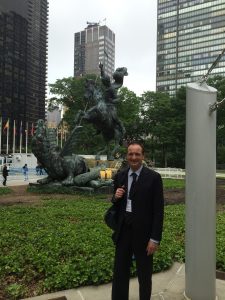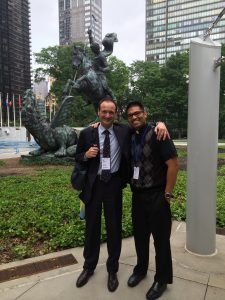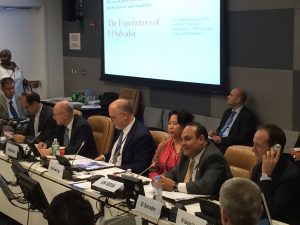SPORTS FOR INCLUSIVE DEVELOPMENT AND EMPOWEREMENT FOR PERSONS WITH DISABILITIES
Introduction:
There are approximately one billion persons with disabilities in the world, amounting to 15 percent of the global population. Evidence suggests that persons with disabilities are disproportionately represented among the world’s poor. Children with disabilities are less likely to attend school, which in turn decreases their chances of developing skills for future employment opportunities. This kind of exclusion, both economic and social, breaches the human rights fo the world’s largest minority and poses a major development challenge. Rich diverse societies that are truly inclusive will help strengthen the enjoyment of fundamental human rights and contribute to development for all its members.
Here is a talk given by Salvatore Cimmino on June 10, 2014 at the United Nations in New York, USA.
Today I find myself in a special place, a place of good will, where people meet at the global level to find solutions to the problems afflicting the planet and its inhabitants.
It is a great honor to be able to speak here today to bring you my story in the hope that even this small life experience can contribute to the universal vision of the United Nations.
I have been disabled since I was fourteen, when to save my life, my doctors decided they had to amputate my right leg, very high up, almost at the height of my groin. This alone tells you how, at the time, the diagnosis of osteosarcoma was complicated and delayed.
While playing basketball with my friends, there was a kick, followed by a pain that would not go away – then an x-ray. The diagnosis was so devastating that my parents, despite taking me immediately to the Rizzoli hospital in Bologna, intimately felt that they had already lost a son.
After the operation, which they say took long, it was very hard for me to get back to some form of normalcy. It took me years of chemotherapy, sessions with the physical therapists at the local healthcare center of Budrio to learn how to walk with prosthesis, which was extremely difficult psychologically.
I was just a kid, struck, at a very delicate stage of development, by a tragedy that my shoulders alone could not bear.
At that time I learned some of the values that I still carry with me today and that I hope to be able to instill in the persons that I meet: solidarity; attention to others; patience; the capability of embracing diversity in a spirit of mutual growth and enrichment.
I learned these values from my family, all of my doctors, nurses, physical therapists who have accompanied me along my path toward healing.
All of this has certainly helped me, but it did not make my life any less challenging, because early on I learned that the world in which we live in is often tailor-made only for people who are perfectly able-bodied and sound.
This, however, instead of discouraging me, actually pushed me a few years ago to put myself out there and tell as many people as possible what the life of a disabled person is like, what are the difficulties and needs, but also what are the disabled person’s potential, and will to participate and be integrated in society.
We launched a project that has brought me to swim in some of the most beautiful places in the world. More importantly, however, this project has allowed me to meet extraordinary and capable people committed to, with enormous faith and generosity, definitively breaking down those architectural and mental barriers that hamper the disabled person’s path toward integration and participation.
I firmly believe that we must acknowledge the fact that for a true democratic society to be realized, it must necessarily be built on total and unyielding inclusion of every individual, to which to offer resources and opportunities for growth and development independently of their initial condition.
This is to say that the “diversely able”, the “handicapped”, the “disabled” or whatever other term we’d like to use, is, first and foremost, a human being, who because his or her diversity, and perhaps by virtue of it, needs to have resources available for a full, fulfilling and productive life.
The lives of the disabled, our lives, unlike what most people may think, have a sense and have a purpose. The difficulties we encounter in managing our everyday life are often heightened, if not created, by a cultural problem that impacts relations between the disabled and the able-bodied creating a distance that impedes integration.
Young disabled persons, in particular, find themselves, besides dealing with the practical issues deriving from their specific physical problem, grappling also with enormous psychological upheavals that are typical of adolescence but which are amplified by the inability to accept their diversity as they see it as an unfair and painful impediment to a full, beautiful life.
When it comes to youths in particular, we must help understand that a disability, if not completely made up for, can, in some cases, be much more easily manageable.
This is owed to a series of factors that are all equally important: I’m referring to the help of parents; to inclusive employment policies; to cultural initiatives that, starting with schools, can be mainstreamed into the entire society, to financial resources channeled specifically toward definitively eliminating architectural barriers everywhere, and to direct, bold intervention in developing countries where disability is often caused by war and healthcare is inadequate, when not completely absent.
Then I think about the enormous extraordinary advances made in scientific research and technology and the need to put in motion those processes that will allow all disabled persons to use them.
I am referring namely to applied technologies for prosthetic devices, which could be suitable for me, but also to the contribution engineering has made to medicine, which in turn has made possible, for example, the production of scarcely invasive devices for the administration of medicine or for the adjustment of ever more sophisticated prostheses, as is the case of the artificial heart.

June 10, 2014 – United Nations, New York – Michael Lenton, Salvatore Cimmino, Alfredo Ferrante, Eugenio Guglielmelli
An important thing that I learned through the years is that you cannot fight against a permanent condition, you must, instead, find a way to accept it, identifying and exalting those abilities that you do have.
I say this because for us disabled persons, sport can be extremely helpful in this sense.
Sport carries meaning and effects that go beyond physical wellbeing. For example, in the case of mental disability, sport can impact logical and intellectual reasoning, and always facilitates inclusion and socialization because it creates, even through recreational activities, experiences and relations that otherwise would be unattainable.
I truly believe that all young people, whether disabled or able-bodied, could find through sport a meeting point from which to start a process of authentic and radical change of society; a process that would finally comprise words like integration and inclusion and that values differences and allows for everyone to contribute to a different way to develop our world, a way that no longer leaves anyone “out” or “behind”.
When I swim I feel the most extraordinary sensations, I am whole again with both my legs; I am running and have no hindrances – neither physical nor mental.
My wish is that in this world we can all run together.
Thank you for you attention, thank you to the Permanent Mission of Italy, thank you all.
Salvatore Cimmino


